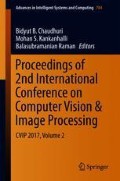Abstract
Human activity recognition is one of the important and difficult problems in computer vision and machine learning applications. Automated human activity recognition system based on dense flow trajectory and hidden Markov model (HMM) is proposed. A 3D dense trajectory was formed by tracking the scale-invariant points from frame to frame. Maximum of 100 points per frame were considered for tracking. Histogram of gradient and dense trajectory descriptor features were extracted from cleaned trajectory and used for training hidden Markov models for each activity. Analysis of variance test resulted in F value of 1150.89 and 74.29 for histogram of gradient (HOG) and dense trajectory descriptor, respectively, for Weizmann database and 187.08 for combined features for videos recorded at Indian institute of technology Patna. Maximum accuracy of 100% is achieved for Weizmann database and IIT Patna database using hierarchical HMM.
Access this chapter
Tax calculation will be finalised at checkout
Purchases are for personal use only
References
R. Huang, V. Pavlovic, and D. N. Metaxas, “Embedded profile hidden markov models for shape analysis,” International Conference on Computer Vision, 2007, pp. 1–8, 2007.
M. Zia Uddin, J. J. Lee, and T.-S. Kim, “Independent shape component-based human activity recognition via hidden markov model,” Applied Intelligence, vol. 33, no. 2, pp. 193–206, 2010.
Y. Chen, Q. Wu, and X. He, “Human action recognition by radon transform,” IEEE International Conference on Data Mining Workshops, pp. 862–868, 2008.
S. S. Kumar and M. John, “Human activity recognition using optical flow based feature set,” IEEE International Carnahan Conference on Security Technology, pp. 1–5, 2016.
M. H. Kolekar and D. P. Dash, “Hidden markov model based human activity recognition using shape and optical flow based features,” IEEE Region 10 Conference, pp. 393–397, 2016.
N. Ikizler and P. Duygulu, “Histogram of oriented rectangles: A new pose descriptor for human action recognition,” Image and Vision Computing, vol. 27, pp. 1515–1526, 2009.
M. A. R. Ahad, J. K. Tan, H. Kim, and S. Ishikawa, “Motion history image: its variants and applications,” Machine Vision and Applications, vol. 23, pp. 255–281, 2012.
R. Zheng, C. Yao, H. Jin, L. Zhu, Q. Zhang, and W. Deng, “Parallel key frame extraction for surveillance video service in a smart city,” PloS one, vol. 10, p. e0135694, 2015.
H. A. Abdul-Azim and E. E. Hemayed, “Human action recognition using trajectory-based representation,” Egyptian Informatics Journal, vol. 16, pp. 187–198, 2015.
H. Rai, M. H. Kolekar, N. Keshav, and J. Mukherjee, “Trajectory based unusual human movement identification for video surveillance system,” Progress in Systems Engineering, pp. 789–794, 2015.
D. G. Lowe, “Distinctive image features from scale-invariant keypoints,” International journal of computer vision, vol. 60, pp. 91–110, 2004.
C. Yıldız, “An implementation on histogram of oriented gradients for human detection,” Bilkent University, 2012.
W.-C. Lu, Y.-C. F. Wang, and C.-S. Chen, “Learning dense optical-flow trajectory patterns for video object extraction,” IEEE International Conference on Advanced Video and Signal Based Surveillance, pp. 315–322, 2010.
W. N. A. W. Samsudin and K. H. Ghazali, “Motion detection using horn-schunck optical flow.” FGIT-FGCN/DCA, pp. 202–209, 2012.
M. H. Kolekar and D. P. Dash, “A nonlinear feature based epileptic seizure detection using least square support vector machine classifier,” TENCON IEEE Region 10 Conference, pp. 1–6, 2015.
M. H. Kolekar and S. Sengupta, “Hidden markov model based structuring of cricket video sequences using motion and color features.” ICVGIP, pp. 632–637, 2004.
J. Yamato, J. Ohya, and K. Ishii, “Recognizing human action in time-sequential images using hidden markov model,” Computer Society Conference on Computer Vision and Pattern Recognition, pp. 379–385, 1992.
M. H. Kolekar and S. Sengupta, “Hierarchical structure for audio-video based semantic classification of sports video sequences,” Proc. of SPIE, vol. 5960, pp. 596 017–1.
M. H. Kolekar, D. P. Dash, and P. N. Patil, “Support vector machine based extraction of crime information in human brain using ERP image,” International Conference on Computer Vision and Image Processing, pp. 163–174, 2017.
H. Byun and S.-W. Lee, “Applications of support vector machines for pattern recognition: A survey,” Pattern recognition with support vector machines, pp. 213–236, 2002.
M. Blank, L. Gorelick, E. Shechtman, M. Irani, and R. Basri, “Actions as space-time shapes,” International Conference on Computer Vision, pp. 1395–1402, 2005.
M. H. Kolekar and S. Sengupta, “Bayesian network-based customized highlight generation for broadcast soccer videos,” IEEE Transactions on Broadcasting, vol. 61, pp. 195–209, 2015.
M. H. Kolekar, “Bayesian belief network based broadcast sports video indexing,” Multimedia Tools and Applications, vol. 54, pp. 27–54, 2011.
Author information
Authors and Affiliations
Corresponding author
Editor information
Editors and Affiliations
Rights and permissions
Copyright information
© 2018 Springer Nature Singapore Pte Ltd.
About this paper
Cite this paper
Dash, D.P., Kolekar, M.H. (2018). Dense Optical Flow Trajectory-Based Human Activity Recognition Using Hierarchical Hidden Markov Model. In: Chaudhuri, B., Kankanhalli, M., Raman, B. (eds) Proceedings of 2nd International Conference on Computer Vision & Image Processing . Advances in Intelligent Systems and Computing, vol 704. Springer, Singapore. https://doi.org/10.1007/978-981-10-7898-9_9
Download citation
DOI: https://doi.org/10.1007/978-981-10-7898-9_9
Published:
Publisher Name: Springer, Singapore
Print ISBN: 978-981-10-7897-2
Online ISBN: 978-981-10-7898-9
eBook Packages: EngineeringEngineering (R0)

